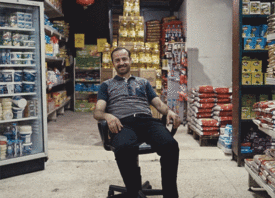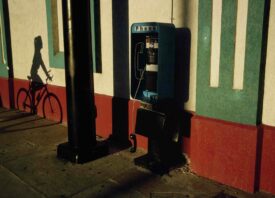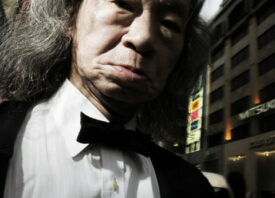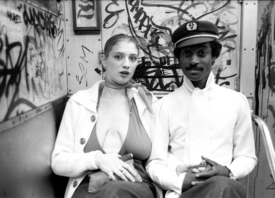Search this site
100 Contemporary Women Street Photographers Redefining the Genre


Growing up in Ufa, the capital of the republic of Bashkortostan, Russia, Gulnara Samoilova fell in love with photography at the age of 15, and quickly discovered it was a means to escape the extremely patriarchal society in which she had been raised. She arrived in the United States in 1992, where she worked at the Associated Press, going on to win first prize in the World Press Photo competition for a photograph she made on September 11.
The trauma of that day affected Samilova for years. She left photojournalism, opening a commercial wedding studio, which she eventually closed when she realized that making money was simply not enough for her soul. By 2015, she reached a crossroads, knowing she had to return to make art, but she wasn’t sure how she would proceed until the 2016 presidential election triggered flashbacks of the sexism Samoilova endured during her formative years.
Recognizing the importance of creating a platform and community to support women, Samoilova launched @WomenStreetPhotographers on Instagram in 2017. The account took off, inspiring her to create a website, traveling exhibitions, artist residency, inspirational film series — and now the new photography book, Women Street Photographers (Prestel).
Featuring the work of 100 contemporary artists from 31 countries pushing the boundaries of street photography in new and exciting directions, Women Street Photographers introduces expansive, experimental, and non-traditional approaches to a genre historically defined by the work of men. Bringing together women of all ages, races, ethnicities, creeds, and sexualities, Samoilova is on a mission to offer the kinds of opportunities and support she wished she had throughout her career.
In advance of the Aperture Conversations April 13 event with Samoilova and Melissa O’Shaughnessy, “Celebrating Women of Street Photography” we showcase the work of seven women featured in the book, who share insights about their work.

Dominique Misrahi
“I always was a photography enthusiast. My parents had a lot of books of old school French photographer so I was exposed since young age. A few years after the birth of my children I decided to buy a camera and take a few classes on digital photography. When the teacher asked me what I wanted to photograph without hesitation I answered, ‘People,’ but I am shy so we went on a tour and he showed me how. I am fascinated by faces and the stories they can tell; I want to show beauty in each of us. That is why I pursue street photography especially street portraits.”

Hazel Hankin
“As a life-long New Yorker who loves urban life, I began shooting in public spaces when I first picked up a camera decades ago, long before street photography became the popular passion it is now. I’m attracted to images that don’t necessarily give up all their meaning on first glance. I like photographs that have a bit of an edge, reveal something unexpected, evoke emotions, resonate with ambiguities, oddities, surprise and wit.
“The image a camera makes captures a specific moment in real time. But the photograph is not reality. It’s an abstraction, a thing unto itself, a fiction that can nevertheless show us something significant about our world. The duality of reality and abstraction and the unique properties of camera-vision fascinate me. Learning to use them creatively has been a life-long pursuit.”

Elena Alexandra
“I love to feel life as you do it in street photography. I enjoy capturing the beauty of everyday moments, to discover magic in ordinary days – every shot you take as a street photographer is ephemeral and unique. Some moments are telling you stories that unveil their deeper meaning only later.
“To me, street photography is a confession of love to life. It is a spiritual experience of a deeper connection with the world surrounding me. With my experience, I can relate to the Freud´s theory of ‘ideational mimetics’ where he stated that an artwork could cause a powerful exchange of energy between viewer and work of art, similar to the experience of empathy. In street photography, you are finding and by documenting it creating an ‘artwork’ in the street.”

B Jane Levine
“I am a candid shooter. I prefer to capture transitory scenes on the street without the knowledge of the subject so that the expression, gesture and/or movement are authentic. Sometimes I get caught and a subject will give me that nod of recognition at the time of the shot or after I press the shutter. I go out with no expectations of subject matter other than looking for a moment, which elicits some emotion that I respond to with the subject, it is mainly driven by an internal signal that connects me to the subject or situation.
“Often, I will shoot a few images and walk on my way, but sometimes I find that a place has great potential and I need the patience to wait around for a scene to evolve. Experimentation keeps me focused and in the moment. I am drawn to creating layered scenes as well as up close candid portraits. I try to respect the subjects that I photograph, taking an image of a fleeting moment, which I observe with no intent other than to memorialize the scene. The resulting photograph is real for the subject/s as well as myself, yet it may not be a truthful representation of what actually occurred.”

Jutharat Pinyodoonyachet
“The most rewarding thing for me about being a street photographer is that I appreciate little things or tiny moments I see in every single day. I usually describe myself as a wallflower. I love to observe things and put them in photographs. That’s what street photography means for me — the celebration of everyday life.
“The most challenging thing about street photography is finding your own voice. We are living in a time where there are thousands of images to look at, hundreds of street photographers to follow. I study other photographers’ work a lot. Seeing too many photographs, sometimes I lost the track in my own work. Lately I don’t really share my work around. I asked only the people I trust. Seeking advice is good but don’t listen to everybody. The most challenging aspect for me is to be unique in your own way.”

Regula Tschumi
“In street photography I find myself confronted with different problems which are mainly connected to the countries or continents where I photograph. In Africa, where I photograph most, I don’t really differentiate between street and documentary photography. What I do in Ghana is a kind of street documentary, different from the street photography I do it in Western countries. Street photography is not popular in Africa, that is why I normally ask before I photograph. I avoid candid street shots, because if somebody sees me, it can create a big problem. Most people don’t understand when a foreigner photographs them.
“Being a white woman holding a camera, what in Ghana is a man’s job, makes my work sometimes also complicated. People see me and I must always try to find ways to get in contact with them. This takes time and patience, especially in the capital Accra. Although I enjoy getting in touch with people, sitting and joking with them, it can also be tiresome. Often, I must explain why I photograph, what I plan to do with the images, I must assure that I won’t make a lot of money with my work and that I am not a journalist searching for some bad things. There is a lot of mistrust towards photographers, this makes it sometimes very difficult.”

Graciela Magnoni
“In street photography, the image can’t be planned or prepared in advance. It can’t be choreographed or controlled either. Things happen quite intuitively. Control and familiarity with the camera help but scenes, people, moments we encounter on the streets are beyond our control, which makes street photography very challenging most of the time. The rate of success to obtain good images is quite low so it can be quite frustrating and discouraging at times. To get the perfect image sounds often like a miracle.
“Walking on the streets without an assignment gives street photographers the opportunity and freedom to find scenes and moments, which can lead to great images. Getting a few of these memorable images are the rewards of a street photographer. Great spontaneous images are powerful, and they make us dream. Great candid images are unique, they can’t be emulated, scenes can’t be re-enacted, moments that can’t be rewound. There is a mystery and a challenge in trying to catch these fleeting moments. The lucky and unexpected surprises we encounter on the street are the most exciting part of street photography. It turns you into an optimistic, sometimes superstitious, life lover and for sure friendlier towards strangers.”

All images: Courtesy of Prestel.



